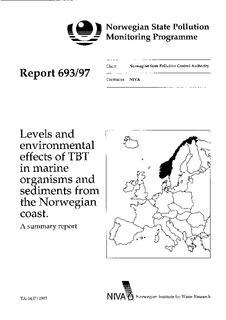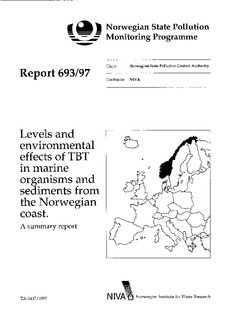| dc.contributor.author | Berge, J. | nb_NO |
| dc.contributor.author | Berglind, L. | nb_NO |
| dc.contributor.author | Brevik, E. | nb_NO |
| dc.contributor.author | Følsvik, N. | nb_NO |
| dc.contributor.author | Green, N. | nb_NO |
| dc.contributor.author | Knutzen, J. | nb_NO |
| dc.contributor.author | Konieczny, R. | nb_NO |
| dc.contributor.author | Walday, M. | nb_NO |
| dc.contributor.other | Berge, J. - Project manager | nb_NO |
| dc.coverage.spatial | Norge | nb_NO |
| dc.date.accessioned | 2014-08-01T10:40:55Z | |
| dc.date.available | 2014-08-01T10:40:55Z | |
| dc.date.issued | 1997 | nb_NO |
| dc.identifier | 3656 | nb_NO |
| dc.identifier.isbn | 82-577-3218-4 | nb_NO |
| dc.identifier.issn | 1894-7948 | nb_NO |
| dc.identifier.uri | http://hdl.handle.net/11250/209369 | |
| dc.description.abstract | Concentrations of TBT in sediments, blue mussels (Mytilus edulis) and dogwhelks (Nucella lapillus) from the Norwegian coast is summarised. The occurrence of imposex in dogwhelks along the coast is given. Most of the sediments contained concentrations below 100 ng/g d.w. Sediment from 16 sites contained more than 1000 ng/g d.w. TBT whereas sediment from 17 sites contained between 100 and 1000 ng/g d.w of TBT. Maximum concentration of TBT was found in sediments from a navy harbour near the city of Bergen (103800 ng/g d.w.). Traces of TBT were, however, also found in sediments from remote, sparsely populated, areas along the coast. The concentrations of TBT in mussels from the Norwegian coast varied from less than 10 µg/kg wet weight to about 3000 µg/kg wet weight. The highest concentrations were found in and around harbours. Some degree of imposex occurred in all populations of dogwhelks except four stations in northern Norway (Finnmark). At about half of the total number of sites, a part of the female dogwhelk population was sterile. The concentration of TBT in the dogwhelks from the unaffected populations in Finmark was below the detection limit (17 ng/g d.w.). The concentration of TBT in dogwhelks from affected populations was in the range 50-2676 ng/g d.w. It was observed a positive relation between concentration of TBT in dogwhelks and the degree of imposex. The results demonstrate that organotin compounds are present in most anthrophogenic influenced areas along the Norwegian coast. The major use of TBT in Norway is in antifouling agents on boats larger than 25 m. Total amount of TBT sold in Norway in 1994 was 36.7 t (23,4 t in antifouling paints for large boats). It is expected that a general reduction in the occurrence of organotin compounds along the Norwegian coast can only be achieved by enforcing restrictions on the use of such compounds on large vessels. | nb_NO |
| dc.description.sponsorship | Statens forurensningstilsyn (SFT) | nb_NO |
| dc.publisher | Norsk institutt for vannforskning | nb_NO |
| dc.relation.ispartofseries | NIVA-rapport;3656 | nb_NO |
| dc.relation.ispartofseries | Overvåkingsrapport;693/97 | nb_NO |
| dc.rights | Navngivelse-IkkeKommersiell-DelPåSammeVilkår 3.0 Norge | nb_NO |
| dc.rights.uri | http://creativecommons.org/licenses/by-nc-sa/3.0/no/ | nb_NO |
| dc.subject | marin undersøkelse undersøkelser-marint | nb_NO |
| dc.title | Levels and environmental effects of TBT in marine organisms and sediments from the Norwegian coast. A summary report | nb_NO |
| dc.type | Research report | nb_NO |
| dc.rights.holder | Norsk institutt for vannforskning/Norwegian institute for water research | nb_NO |
| dc.subject.nsi | VDP::Matematikk og naturvitenskap: 400 | nb_NO |
| dc.source.pagenumber | 36 | nb_NO |
| dc.subject.keyword | tbt | nb_NO |
| dc.subject.keyword | bunnstoff | nb_NO |
| dc.subject.keyword | marin organisme | nb_NO |
| dc.subject.keyword | sediment | nb_NO |
| dc.subject.keyword | tbt | nb_NO |
| dc.subject.keyword | antifouling | nb_NO |
| dc.subject.keyword | marine | nb_NO |
| dc.subject.keyword | organisms | nb_NO |
| dc.subject.keyword | sediment | nb_NO |
| dc.relation.project | O-97016 | nb_NO |


